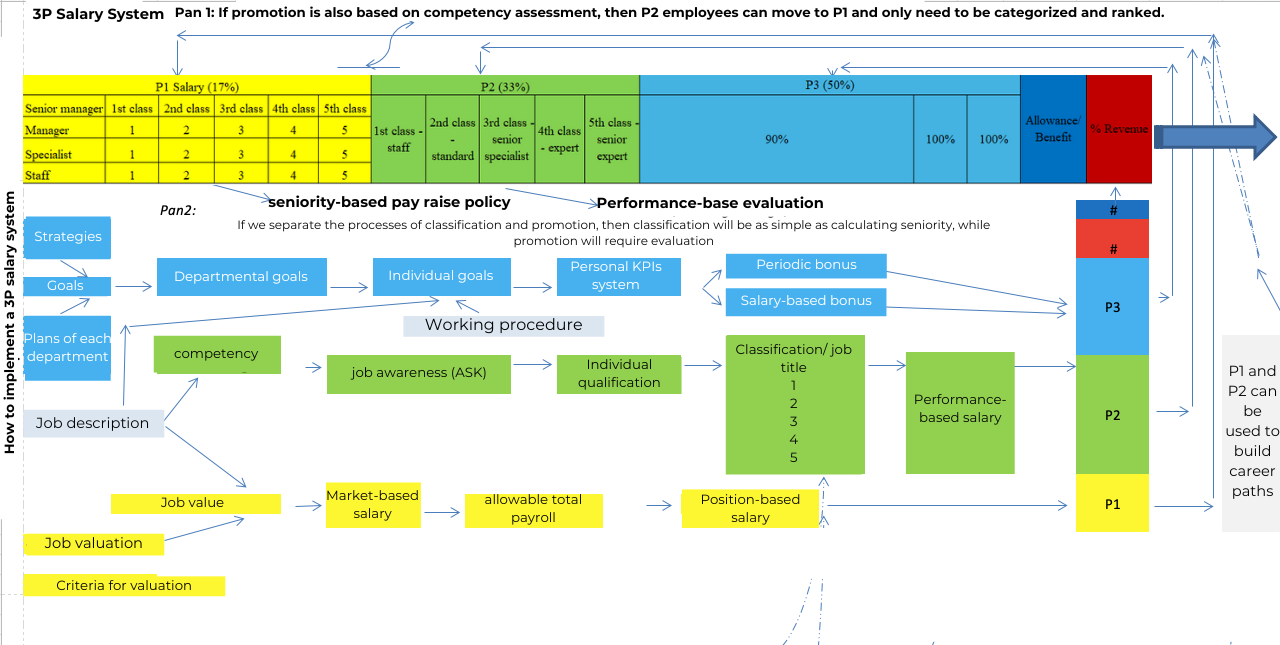
Organizational structure of Vietnamese SMEs
- Board of Directors
- Supervisory Board
- General Director
- Functional Directors:
- Chief Financial Officer (CFO)
- Human Resources & Marketing Director
- Regional Business Director
- Procurement Director
- Production Director
- Operations Director
Current Salary Structure and Issues
Current Status
- The company currently pays salaries based on a time-based system: 8 hours/day, 40 hours/week, 22 days/month.
- The company does not have a formal salary policy. Salaries are determined through negotiations between the company and employees.
- Some positions have special salary arrangements, such as additional payments outside of the regular salary, based on personal relationships, seniority, or not following the company’s salary scale.
- Monthly KPI reviews are conducted, but they are not fully implemented or taken seriously by all departments.
Issues
- There is no basis for assessing the value of positions to determine appropriate salaries based on job roles.
- Salaries are not based on employee capabilities.
- The actual work performance of all employees is not evaluated for salary determination. Evaluations are often procedural and do not reflect actual work results.
- The current salary structure does not promote fairness in compensation, neither between different positions nor between the company and its employees.
- There is no consistency in salary determination, leading to pay disparities for the same positions.
- The current salary structure does not incentivize or motivate employees.
- There is no formal salary policy in place.
ESTABLISHING A SALARY POLICY BASED ON THE 3P METHOD
Purpose of Establishing a Salary Policy
Based on the current salary practices of Vietnamese SMEs, Equitix assists founders in developing a salary policy to provide companies with a scientific and effective compensation tool. A salary policy that ensures three aspects: Fairness – Competitiveness – Rationality.
Theoretical Basis
What is salary?
Salary is the price of labor, an agreement between two parties based on the SUPPLY-DEMAND relationship of labor in the labor market. Companies pay salaries to employees through the 3P salary policy.
Roles and Significance of Establishing a 3P Salary Policy
- Pay fairly based on job position (P1), ability (P2), and work performance (P3).
- Position salary scales on the labor market to have a basis for developing appropriate policies to help the Company achieve its business goals at each time point.
- Help the Company manage its human resources well, plan human resources scientifically and rationally.
Objectives of Establishing a Salary Policy
- Standardize salary payments within the company
- Create fairness and recognize employee contributions
- Motivate employees to work
- Retain talented employees to work for the company in the long term
- Attract talented people
- Ensure that salary payments are effective and in line with the company’s financial capabilities.
- Comply with labor laws
Establishing a 3P salary policy (Position, Person, Performance) based on the following human resource management model:
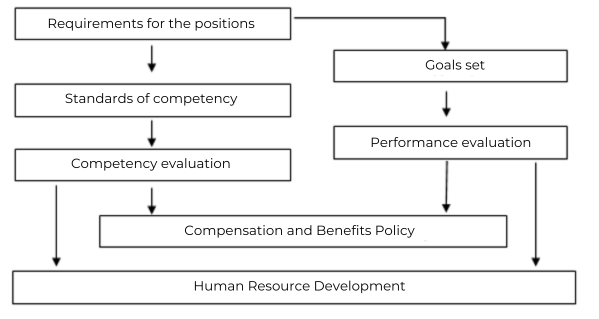
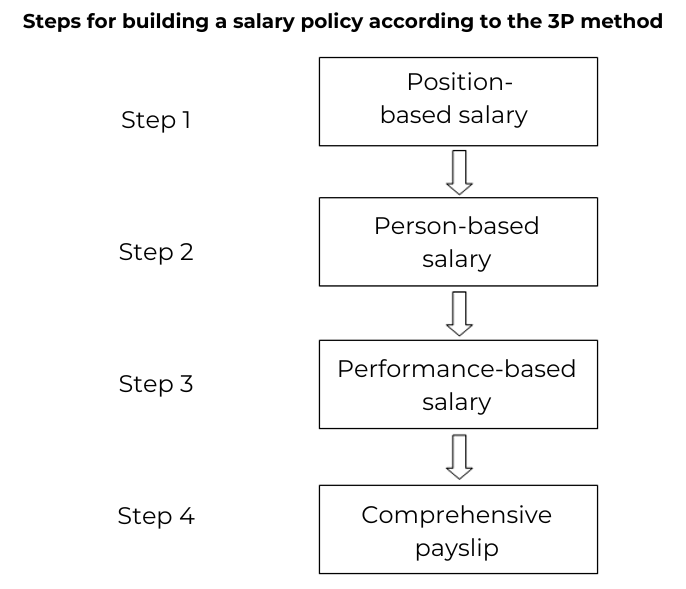
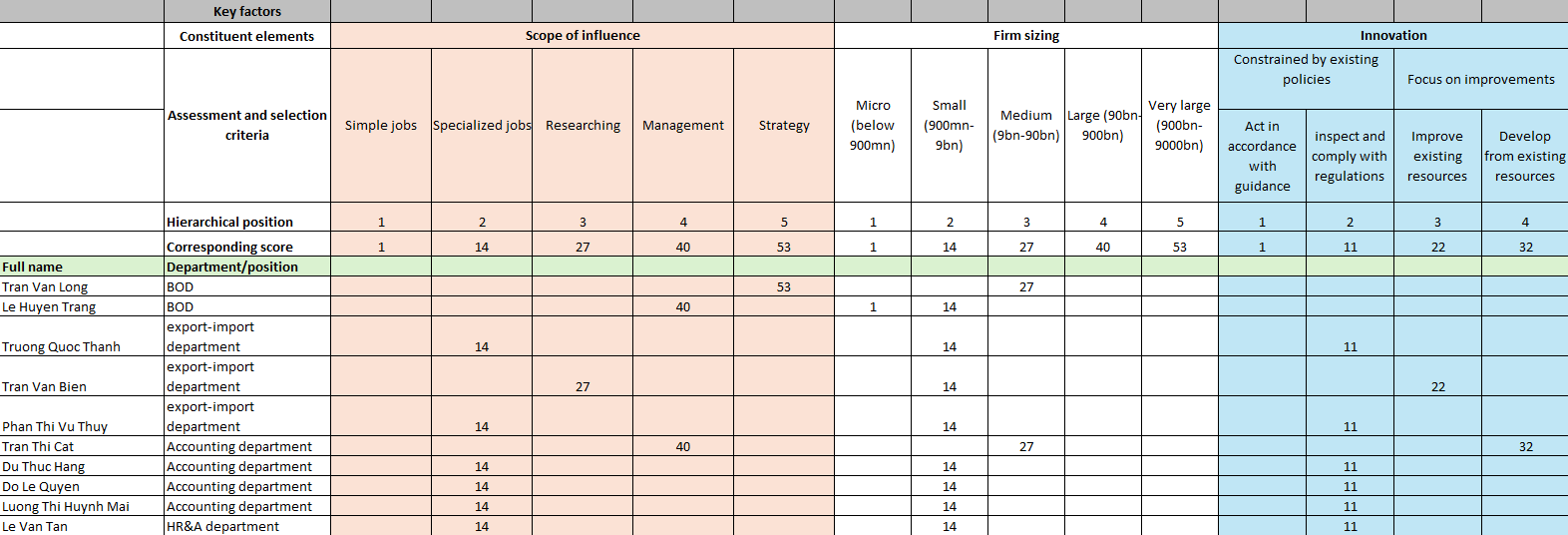
Figure 1
All positions in the company are meticulously and scientifically measured to determine their value, ensuring they align with the company’s salary structure, financial constraints, and appropriate seniority levels based on company size. This approach prevents founders from overpaying or underpaying employees relative to their position and the company’s scale.
Purpose:
-
Before hiring:
- Carefully evaluate the job requirements, title, and seniority level of the position to be filled. This will help determine the job description and profile, which in turn will inform the salary range (Min – Max) and maximize the utilization of each individual’s abilities. Avoid overpaying for talent that exceeds the company’s scale and underpaying for those who lack the required skills for the position.
- Many workplace frustrations and inefficiencies stem from unclear agreements between employers and employees from the very beginning of their employment. Employees may underperform due to (a) not being properly evaluated and recognized for their abilities or (b) being paid more than their true worth.
-
Reevaluate current employees:
- Review the performance of existing employees based on past hiring practices that may have been inadequate. Communicate with the team to inform them of their current level, the appropriate position and title based on the company’s size, and create a plan for evaluation and promotion that is fair for both new and existing employees. This will help prevent new hires with superior skills from outperforming long-time employees who may have close ties to the company or founders, which could hinder the company’s ability to attract and develop talent and manage effectively in the future.
-
Provide a clear career path:
- Outline the development path for each individual to reach new positions based on the requirements and evaluation criteria for their current role. This will motivate employees to work beyond just for the sake of salary and income, which is often the sole reason for joining an organization. Additional factors that can attract and retain talent include:
- A positive and supportive work environment
- A modern company culture and management style
- A well-structured and transparent career progression path
- Fair compensation and promotion based on individual contributions and achievements
- Outline the development path for each individual to reach new positions based on the requirements and evaluation criteria for their current role. This will motivate employees to work beyond just for the sake of salary and income, which is often the sole reason for joining an organization. Additional factors that can attract and retain talent include:
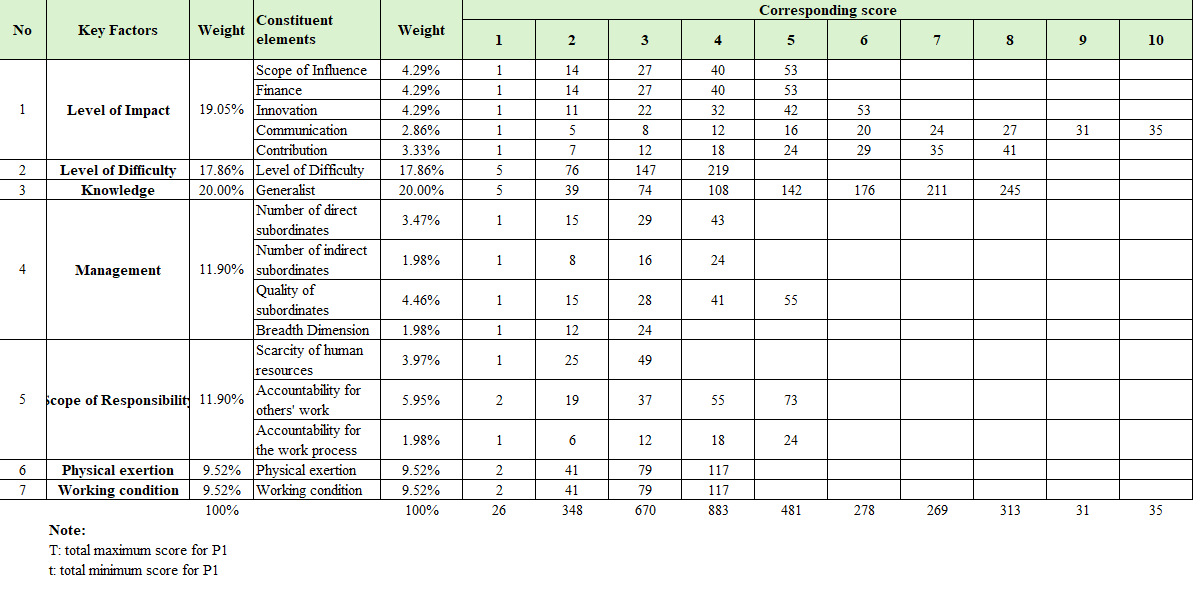
Figure 2
The factors influencing the salary of an employee in the company, helping founders determine the exact salary level, not too high and not too low.
The logic derives from evaluating factors influencing a job title’s worth: a) CV characteristics, b) revenue scale, and c) existing salary range (min-max) to keep total payroll costs in line with company size and human resources.
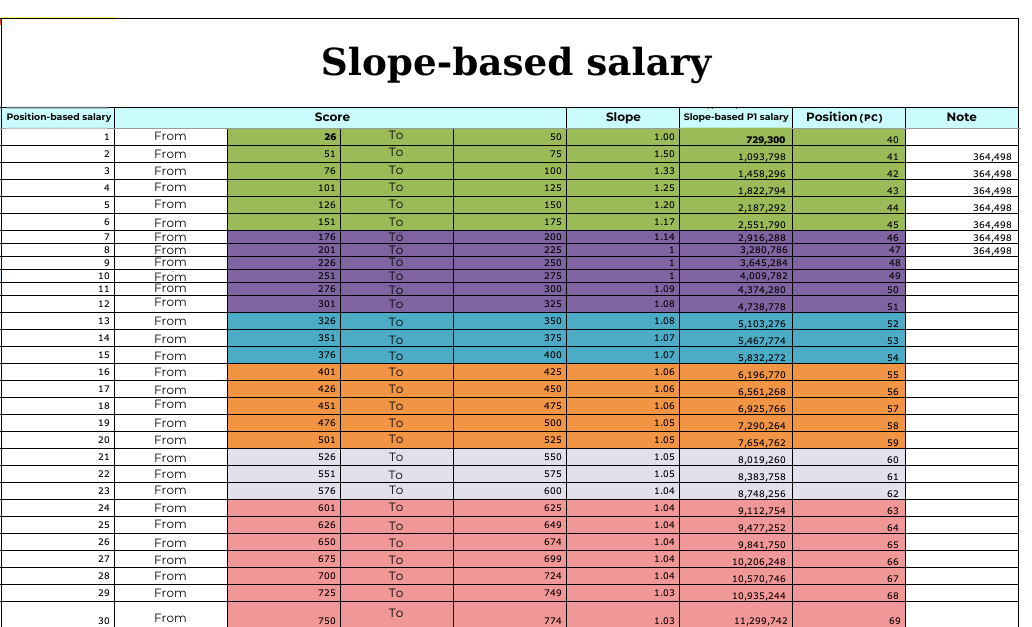
Figure 3
Based on the scores obtained from the table above, we have established a salary range for each position in the company that is commensurate with the nature of the work in that position
“There are two salary tracks:
-
Specialist: Focuses on technical expertise
-
Manager: Focuses on people management
Ranks:
-
Green: Staff
-
Purple: Supervisor
-
Blue: Manager
-
Orange: Functional Director
-
Light Gray: Deputy General Director
-
Pink: General Director”
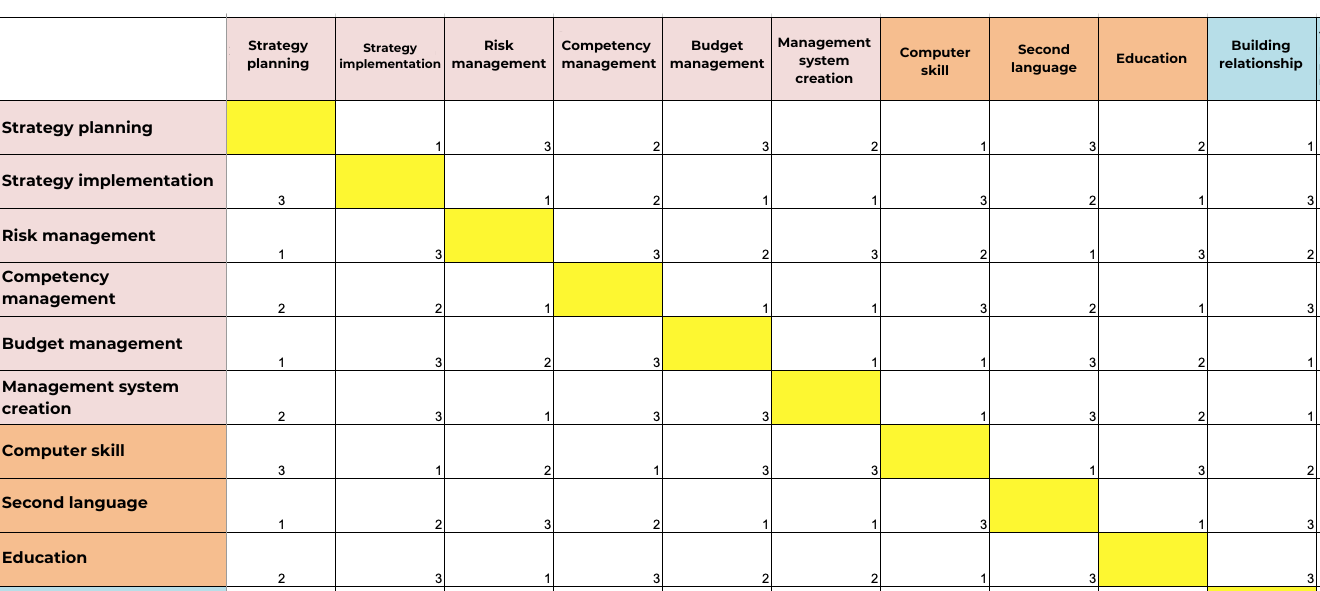
Figure 4
Comparision Method
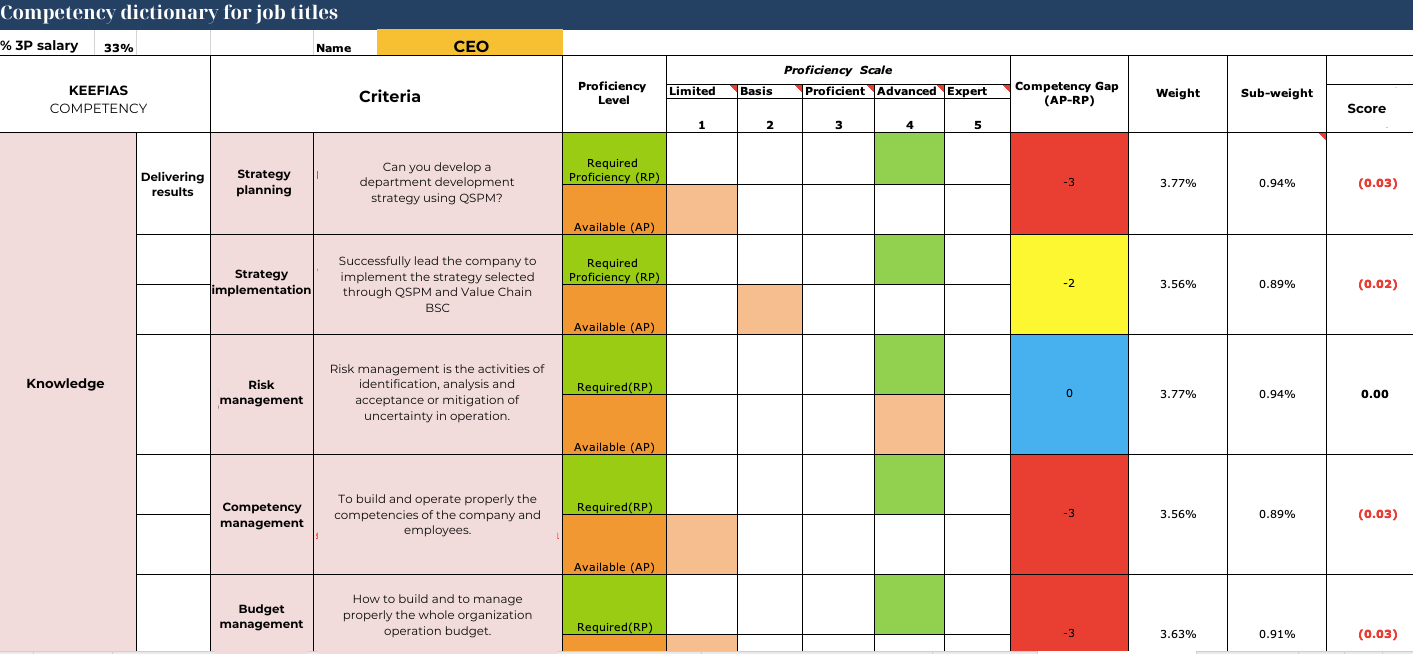
Figure 5
Establishing a competency dictionary based on ethics, talent, and a career development roadmap
Level 7 (General Laborer)
Level 6 (Executor)
Level 5 (Supervisor)
Level 4 (Manager)
Level 3 (Director)
Level 2 (Deputy General Director)
Level 1 (General Director)
With an effective management structure of 6-8 employees, there will be one direct manager.
Therefore, for SMEs with a scale of 40-50 people, the highest position in the company is only Manager. The CEO is the General Manager, not the General Director – which is equivalent to a scale of 360-800 billion VND/year.
Each position in these levels has regulations on the required competencies at all three levels: Strategy, administration, management, and expertise/execution with a management structure appropriate to the scale of revenue and financial anchoring.
In each level in the organizational chart, there is a career development path for each department. There will be a corresponding competency dictionary that clearly specifies the competency requirements for each level and position: Scientific, fair, transparent, and with a path for striving, learning, and promotion.
Competency Dictionary – KEEFIAS:
K – Knowledge: Knowledge
E – Education: Education
E – Experience: Experience
S – Skill: Skills
F – Flexibility: Flexibility
I – Interaction: Interaction
A – Attitude: Attitude
KEES: Talent, skills, experience, methods to complete a work.
FIA: Ethics, harmony to get things done, willingness to cooperate and strive to complete work.
Required Proficient: Required proficiency for the job title and level.
Available: The applicant’s current level of competence.
Competency Factor Proficiency Levels:
Limited: No need to know
Basic
Proficient: Sufficient to work
Advanced
Expert
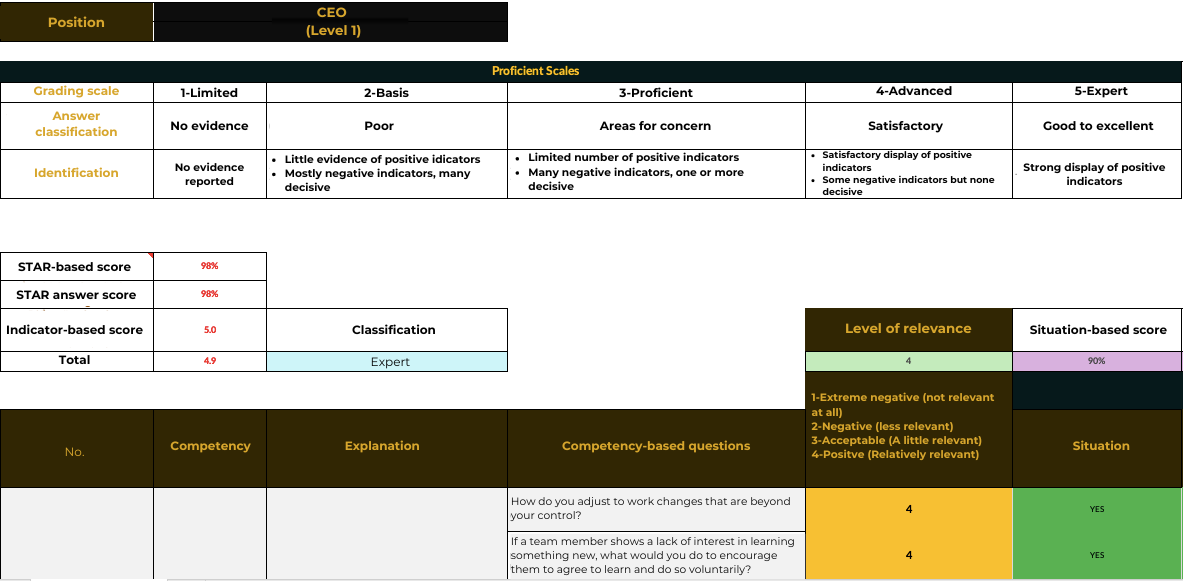
Figure 6
A scientific approach to evaluating employee competencies based on ethics and talent using the STAR (Situation, Task, Action, Result) criteria
This should be organized annually to serve as a basis for scientific salary increases – Performance Review.
The interviewer is also qualified and experienced enough to evaluate objectively and qualitatively according to the employee’s career path.
Competency – asked Questions: A set of questions for interviewing and asking each competency to be scored according to the STAR standard.
Number of competencies: 70 – 90 competencies for each department.
Analyze which level of competence the interviewed employee has compared to the rank and if there is a deviation from the standard of competence, what do you need to improve to get a higher salary.
This means that if a younger employee can prove their work results and competence according to KEES – FIA, they will still be promoted, seniority is just a minor criterion in the factors to consider a person, from there the whole organization will strive for the benefit and development of itself.
Indirectly, founders will create an organization that is self-motivated to learn and progress and help the company achieve its financial and business goals.
Each year, when the salary fund and cost structure do not change significantly, the better the team, the more profit the organization will earn.
Don’t let the year-end party (YEP) honor, we reward and promote the wrong way to make employees feel inhibited and … go to work for other companies.

Figure 7
How the BSC – KPIs Salary Table for the CFO – Chief Financial Officer position influences business strategy from the beginning of the year, allocation to departments, to each individual, and how they are closely linked together to achieve the financial plan (Revenue, Expenses, Profit) in the fiscal year.
How will the other positions in the company: Sales, Marketing, RnD, HR, Accounting, Supply Chain, Delivery, Production, IT be structured? Let’s discuss this with Equitix, focusing on the close relationship between:
- Company’s financial strategy
- Company’s financial actions
- Financial actions of each department
- Financial actions of each individual by rank
- Individual KPIs
- Aligning year-end goals with department and individual goals
- Individuals achieving KPI goals, teams and departments achieving KPI goals, Founder/CEO and Board of Directors achieving financial results according to annual KPIs.
- Reports and forms are built according to the BSC – KPIs of each individual involved and are closely linked together
- Basis for individual promotion based on data, financial performance and promotion, salary increase.
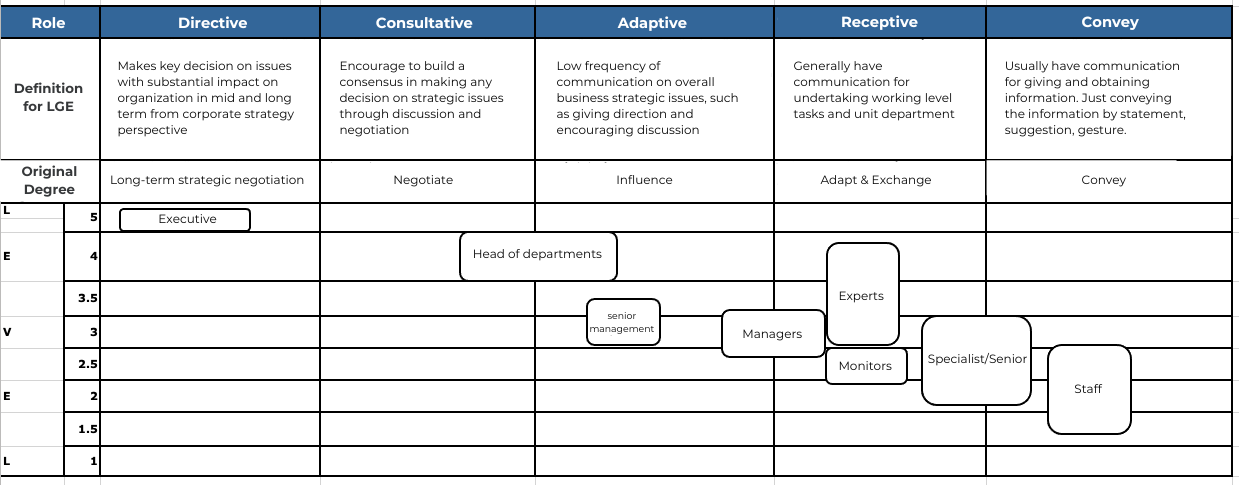
Figure 8
Communication Level Assessment Model for Company Hierarchies
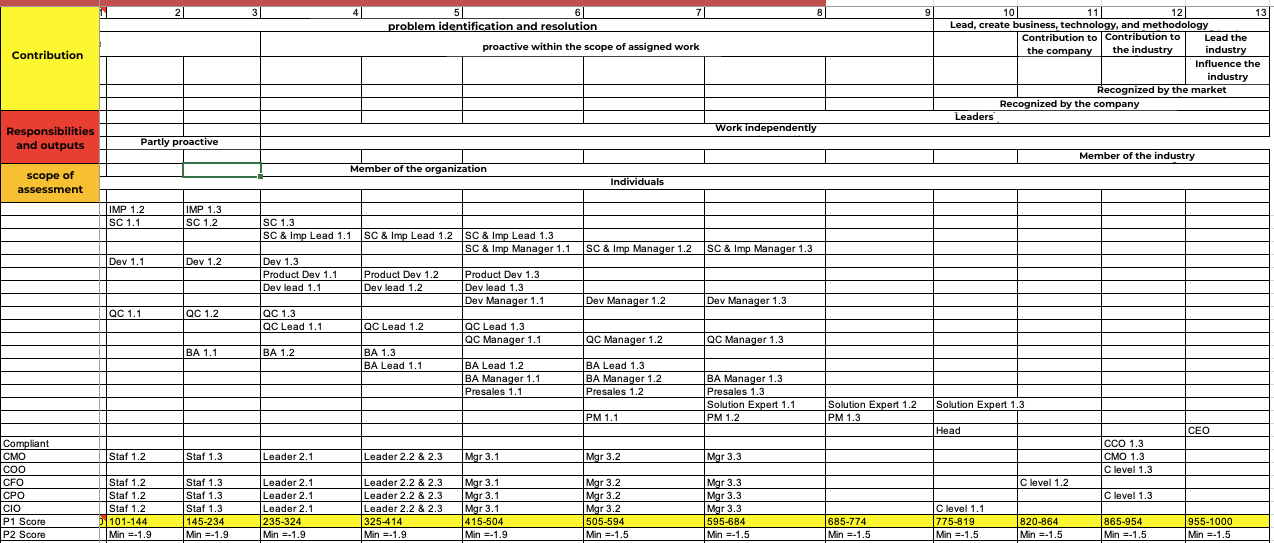
Figure 9
Ranking the Influence and Contribution Value of Company Hierarchies
Equitix Investing employees are all capable of negotiating their salaries with recruiters because they have a very detailed evaluation system.
Recruiters, on the other hand, have not yet built one.
If you want to be one of the few companies that are methodical about building a 3P & BSC – KPIs salary system, contact Equitix now!
Currently, Equitix offers intensive founder-focused courses on management, governance, and in-depth business understanding from a financial perspective, as follows:
a) Course 01: Finance & Accounting for non-finance founders: learn to speak the same language as your finance and accounting team for business operations and asset management, and understand the language of shareholders and professional financial investors.
- 4-6 sessions
- Tuition fee: VND7.5mn /person
- Early bird registration: VND6.9mn/person
- Group registration: VND6.5mn/person
b) Course 05: Business Operations, Organization & Management According to Financial Plan (Revenue, Expenses, Profit)
- 4 – 5 sessions Tuition fee: VND6.5mn/person
- Early bird registration: VND5.9mn/person
- Group registration: VND5.5mn/person
c) Course 02: In-depth BSC Course – KPIs, From Strategy to Implementation in the Process of Receiving Capital from Investors 12 sessions
- Tuition fee: 35,000,000 VND/person
- Early bird registration fee: 32,500,000 VND/person
- Group registration fee:
- Group of 2: 32,000,000 VND/person
- Group of 3-4: 31,000,000 VND/person
- Group of 5 or more: 29,000,000 VND/person
d) Special Discount Course: 39,000,000 vnd (Original Price: 49,000,000 vnd). Students will have access to all of Equitix’s online and offline courses for 1 year.
e) 1:1 Finance Mentorship Program
- Evening sessions (6-10 sessions)
- Tuition fee will be quoted based on individual needs (after a 1:1 interview) and will vary depending on the business model, existing accounting data, the specific challenges faced by the founders, and the need for privacy and data security.
f) F1 Mentoring Program – Asset Management
- Tuition fee will be quoted based on individual needs (after a 1:1 interview) and will vary depending on the business model and your level of commitment.
